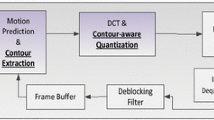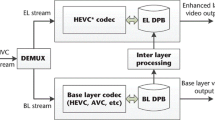Abstract
Being a scalable extension of the High Efficiency Video Coding (HEVC), Scalable High Efficiency Video Coding (SHVC) standard makes it possible to perform scalable encodings. It produces a single binary stream over several layers built from the same video at different scales of resolutions, frequencies, qualities, pixel depths, or color dynamics. However, SHVC is dedicated to the scalable compression of conventional 2D videos whose only component is the texture image, while a compact and highly scalable representation of depth data is also required in several innovative current and future applications. Finalized in February 2015, 3D High Efficiency Video Coding (3D-HEVC) was introduced as a standard dedicated to depth maps compression. But, it does not allow scalable compression of these latter. We are then faced with 3D-HEVC, a standard adapted to depth maps but not scalable, and SHVC, a standard for scalable compression but not adapted to depth maps. In this paper, we aim to propose our custom SHVC in order to handle the signal-to-noise ratio (SNR) scalable compression of depth maps. This codec consists in limiting SNR scalability to sharp depth discontinuities and their neighborhoods. Increasing quantization parameters values are then conditionally used for the quantization of the coding units transform coefficients as we move away from the contours. Our tailored SHVC codec, when compared to the unmodified SHVC and a 3D-HEVC-based state-of-the-art method, significantly improves the distortion vs. rate performance for benchmark depth maps sequences.







Similar content being viewed by others
Notes
Spearman Rank-Order Correlation Coefficient
Kendall Rank-Order Correlation Coefficient
Pearson Linear Correlation Coefficient
References
Merkle, P., Smolic, A., Müller, K., Wiegand, T.: Multi-view video plus depth representation and coding. In: International Conference on Image Processing(ICIP), San Antonio (2007)
Ying, C., Karsten, M., Jens-Rainer, O., Anthony, V., Ye-Kui, W.: Overview of the multiview and 3D extensions of high efficiency video coding. IEEE Trans. Circuits Syst. Video Technol. 26(7), 35–49 (2016)
Mosbah, S., Sebai, D., Ghorbel, F.: Conditional quantization for SHVC quality scalability of depth maps. In: International Conference on Telecommunications and Signal Processing (TSP) (2021)
Sebai, D., Mosbah, S., Ghorbel, F.: Edge-aware coding tree unit hierarchical partitioning for quality scalable compression of depth maps. Multimedia Syst. 27, 893–906 (2021)
Li, Y., Sjöström, M., Jennehag, U., Olsson, R.: A scalable coding approach for high quality depth image compression. In: 3DTV-Conference: The True Vision Capture, Transmission and Display of 3D Video, Zurich (2012)
Zhang, M., Lu, H., Bai, H.: Interlayer simplified depth coding for quality scalability on 3D high efficiency video coding. Sci. World J. 2014, 16–20 (2014)
Li, Y., Mathew, R., Taubman, D.: Scalable mesh representation for depth from breakpoint-adaptive wavelet coding. In: International Workshop on Multimedia Signal Processing, Finland (2020)
Kang, J., Jeong, H., Chung, K.: Scalable depth map coding for 3D video using contour information. In: Annual ACM Symposium on Applied Computing, New York (2012)
SHM software repository. https://hevc.hhi.fraunhofer.de/svn/svn_SHVCSoftware/tags/SHM-12.0/
Scharstein, D., Szeliski, R., Zabih, R.: Taxonomy and evaluation of dense two-frame stereo correspondence algorithms. Int. J. Comput. Vis. 47(1), 7–42 (2002)
Wang, C., Han, Y., Wang, W.: An end-to-end deep learning image compression framework based on semantic analysis. Appl. Sci. 9(17), 3580 (2019)
Wang, Z., Bovik, A., Sheikh, H., Simoncelli, E.: Image quality assessment: from error visibility to structural similarity. IEEE Trans. Image Process. 13(4), 600–612 (2004)
Mohammadi, P., Ebrahimi-Moghadam, A., Shirani, S.: Subjective and objective quality assessment of image: a survey. arXiv:1406.7799 (2014)
Author information
Authors and Affiliations
Corresponding author
Additional information
Publisher's Note
Springer Nature remains neutral with regard to jurisdictional claims in published maps and institutional affiliations.
Rights and permissions
About this article
Cite this article
Sebai, D., Mosbah, S. & Ghorbel, F. SNR scalable coding of depth maps using contour-centric SHVC enhancement sublayers. SIViP 17, 509–517 (2023). https://doi.org/10.1007/s11760-022-02255-7
Received:
Revised:
Accepted:
Published:
Issue Date:
DOI: https://doi.org/10.1007/s11760-022-02255-7




